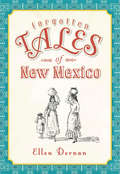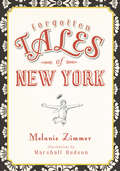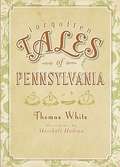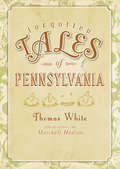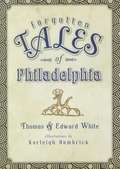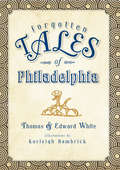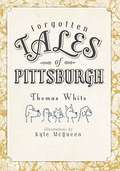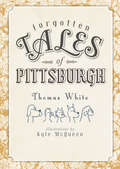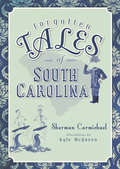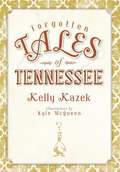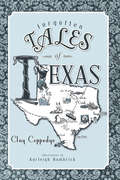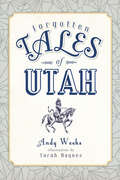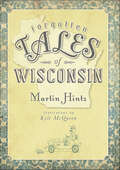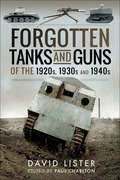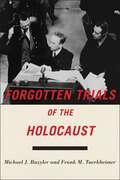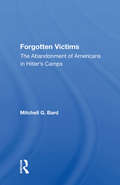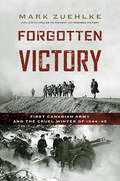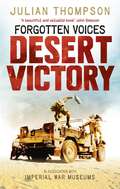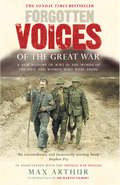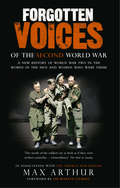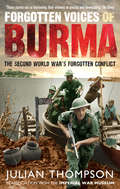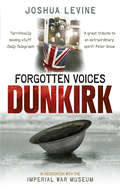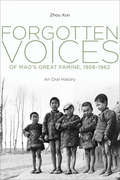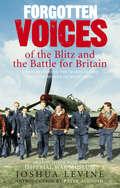- Table View
- List View
Forgotten Tales of New Mexico (Forgotten Tales)
by Ellen DornanNew Mexico, a place defined by a history of grand conflicts, conquistadores, Pueblo warriors, and nuclear scientists, will celebrate its state centennial in 2012. What better time for a collection of forgotten tales that recounts the adventures and exploits of priests, soldiers, witches, and politicians, who carved out a living in the harsh frontier. Ellen will introduce the reader to a cross-dressing Buffalo Soldier, a French trailblazer who opened a road from Santa Fe to Texas, an American spy who became a Mexican general, a Mexican raised by the Navajo who helped round up the Din for removal, and a governor whose head was removed and used as a football. Spanning from the 17th century to World War II, these stories are drawn from Native oral histories as well as the state's written records, and provide a sampling of New Mexico's colorful past.
Forgotten Tales of New York (Forgotten Tales Ser.)
by Melanie ZimmerLearn the Empire State&’s little known history—from bone-stealing dogs to the world&’s largest puzzle—by the author of Curiosities of the Finger Lakes. Few New Yorkers remember the night when firemen, in tuxedos and top hats, were dragged from a ball to extinguish a Waterloo blaze, or the typographical error that reported Theodore Roosevelt taking a &“bath&” instead of his presidential &“oath.&” Still fewer remember Cephas Bennett, a missionary from Utica and printer of the first Burmese Bible, or H. L. Mencken&’s humorous article on the history of the bathtub, still quoted today as factual although entirely invented. Seasoned storyteller Melanie Zimmer seamlessly weaves together these hard-to-believe, yet entirely true, tales. From the monster of Seneca Lake to the man who inspired the American icon Uncle Sam, discover the lost secrets of the Empire State. Includes photos!
Forgotten Tales of Pennsylvania
by Thomas WhiteWilliam Penn, the might of Pittsburgh steel and the Revolutionary figures of Philadelphia dominate the scene of Pennsylvania history. Thomas White brings together a collection of tales that have been cast in the shadows by these giants of the Keystone State. From the 1869 storm that pelted Chester County with snails to the bloody end of the Cooley gang, White selects events with an eye for the humorous and strange. Mostly true accounts of cannibalistic feasts, goat-rescuing lawmen, heroic goldfish, the funeral of a gypsy queen and a Pittsburgh canine whose obituary was featured in the "New York Times" all leap from the lost pages of history.
Forgotten Tales of Pennsylvania (Forgotten Tales)
by Thomas White Marshall HudsonWilliam Penn, the might of Pittsburgh steel and the Revolutionary figures of Philadelphia dominate the scene of Pennsylvania history. Thomas White brings together a collection of tales that have been cast in the shadows by these giants of the Keystone State. From the 1869 storm that pelted Chester County with snails to the bloody end of the Cooley gang, White selects events with an eye for the humorous and strange. Mostly true accounts of cannibalistic feasts, goat-rescuing lawmen, heroic goldfish, the funeral of a gypsy queen and a Pittsburgh canine whose obituary was featured in the New York Times all leap from the lost pages of history.
Forgotten Tales of Philadelphia
by Thomas White Edward WhiteRecounts little-known, obscure, bizarre, and sometimes funny tales from the Philadelphia area
Forgotten Tales of Philadelphia (Forgotten Tales)
by Thomas White Edward WhiteA twelve-foot bull shark in the Delaware, the 1856 tornado that tore through Kensington and the four-elephant battle royal that rolled into Fair Hill Junction are among the bizarre tales that are too often overlooked in the history of Penn's Holy Experiment. Authors Thomas and Edward White have intrepidly stormed the stacks to unearth this offbeat collection of strange stories and weird lore with accounts of body snatchers, witch trials and a snake-wielding lunatic. From the outlawing of tambourine beating to the posse that caught a "ghost" and everything in between, the Brothers White take a wickedly gleeful romp through the freak happenings, dastardly deeds and unbelievable characters that lurk in the lost chronicles of the City of Brotherly Love.
Forgotten Tales of Pittsburgh
by Thomas WhiteSuch was the wisdom of the Pittsburgh Daily Gazette and Advertiser in 1866 when describing a railway boss's threat to decapitate a former employee. Pittsburgh has many such stories of strange but mostly true events. Local author Thomas White delves into these lost tales, from Lewis and Clark's inauspicious start involving an intoxicated boat builder to the death ray of inventor Nikola Tesla. A 1907 lion attack at Luna Park, death by spontaneous combustion, Jack the Ripper's rumored visit to the city and an umpire who was rescued from an angry crowd by Pirates players are all part of the forgotten history of the Steel City.
Forgotten Tales of Pittsburgh (Forgotten Tales)
by Thomas White Kyle McqueenSuch was the wisdom of the Pittsburgh Daily Gazette and Advertiser in 1866 when describing a railway boss's threat to decapitate a former employee. Pittsburgh has many such stories of strange but mostly true events. Local author Thomas White delves into these lost tales, from Lewis and Clark's inauspicious start involving an intoxicated boat builder to the death ray of inventor Nikola Tesla. A 1907 lion attack at Luna Park, death by spontaneous combustion, Jack the Ripper's rumored visit to the city and an umpire who was rescued from an angry crowd by Pirates players are all part of the forgotten history of the Steel City.
Forgotten Tales of South Carolina (Forgotten Tales)
by Sherman CarmichaelFrom the desk of Sherman Carmichael comes a collection of about a hundred quirky and unpublished tales from the Palmetto State. Tales include everything from folk tales, urban legends, monsters, mermaids, ghost sightings, mysterious lights, UFO sightings, dinosaurs, and haunted locations.
Forgotten Tales of Tennessee (Forgotten Tales)
by Kelly KazekTennessee has never been a stranger to strangeness. Stories of the weird, wild and wonderful abound in the Volunteer state. Join author and seasoned journalist Kelly Kazek as she tracks down the extraordinary stories that other history books overlook. Each section covers a different outlandish theme of Tennessee history colorful characters, strange sites, intriguing incidents, tombstone tales, odd occurrences and curious creatures. Readers will discover the brilliant phenomenon of synchronized firefly flashes in the Smoky Mountain town of Elmont, take on the world's largest Moon Pie in Chattanooga and learn Tennessee's history of damaging earthquakes. From the humorous to the haunting, the madcap to the macabre, Forgotten Tales of Tennessee offers a collection as remarkable as the state itself.
Forgotten Tales of Texas (Forgotten Tales)
by Clay CoppedgeFrom El Chupacabra to the Marx Brothers, Clay Coppedge has a talent for digging into Texas's most unusual history. Strange as they may seem, many of these Texas-sized legends are surprisingly true, like Pancho Villa's film contract and the notorious Crash at Crush, a staged train collision and failed publicity stunt that turned tragic outside of Katy. Whether fact or lore, each tale is irrefutably part of a unique and fascinating heritage that invigorates the spirit like a Texas frontier remedy.
Forgotten Tales of Utah (Forgotten Tales)
by Andy WeeksCharacters ranging from Mormon pioneers to Butch Cassidy all helped give the Beehive State color and tenacity. Uncover the state’s hidden gems with stories like the first group of Latter-day Saints who arrived in the Salt Lake Valley days before Brigham Young proclaimed it as “the right place.” Meet an ancient prophet believed to have walked the arid landscape, offering his blessing on several sites long before the pioneers arrived. Learn why a former lawyer was buried without a proper headstone. Discover the state’s quirky side with the strange goings-on at an obscure ranch and the alleged monsters once believed to haunt some of Utah’s lakes. Author Andy Weeks offers this quirky and informative collection of little-known tales about the forty-fifth state.
Forgotten Tales of Wisconsin (Forgotten Tales)
by Martin HintzDrift back to an era when the speed limit in Milwaukee was an edgy four miles per hour and Madison lawmakers could poke at hogs to punctuate the tedium of legislative sessions. Martin Hintz makes even the slow times of the Badger State fly by in this collection of Wisconsin's forgotten memories. Taste the world's first batch of pink lemonade (made with the dye of a circus performer's pants) and witness the tragic death of the world's last wild passenger pigeon. Track down ancient Algonkin legends like the great serpent that swam up the Mississippi looking for copper, and drop in on modern legends like Les Paul, whose guitar spun records into gold.
Forgotten Tanks and Guns of the 1920s, 1930s and 1940s
by David ListerHistory forgets. Files are lost and mislaid. But this book seeks to shine a light, offering a collection of cutting edge pieces of historical research detailing some of the most fascinating arms and armament projects from the 1920s to the end of the 1940s, nearly all of which had previously been lost to history.Included here are records from the UKs MI10 (the forerunner of GCHQ) which tell the story of the mighty Japanese heavy tanks and their service during the Second World War. Other chapters expand on the development of British armour, including the story of infantry tanks from the 1920s right through to the end of the Second World War and beyond.Other items placed beneath the microscope in this fascinating history include a wide variety of guns, rocket launchers, super heavy tanks and countless pieces of specialised armour. Previously overlooked, hidden under layers of dust in archives up and down the country, the histories of these objects has finally been uncovered.
Forgotten Trials of the Holocaust
by Michael J. Bazyler Frank M. TuerkheimerIn the wake of the Second World War, how were the Allies torespond to the enormous crime of the Holocaust? Even in an ideal world, itwould have been impossible to bring all the perpetrators to trial.Nevertheless, an attempt was made to prosecute some. This book uncovers ten “forgotten trials” of the Holocaust,selected from the many Nazi trials that have taken place over the course of thelast seven decades. It showcases how perpetrators of the Holocaust were dealtwith in courtrooms around the world, revealing how differentlegal systems responded to the horrors of the Holocaust. The book provides agraphic picture of the genocidal campaign against the Jews through eyewitnesstestimony and incriminating documents and traces how the public memory of theHolocaust was formed over time.
Forgotten Victims: The Abandonment Of Americans In Hitler's Camps
by Mitchel G BardThe outbreak of war in Europe in 1939 put tens of thousands of American civilians, especially Jews, in deadly peril, and yet the US State Department failed to help them. Consequently many suffered and some died. Later, when the United States joined the war against Hitler, many American and, in particular, Jewish American soldiers were captured and
Forgotten Victory
by Mark ZuehlkeDuring the winter of 1944-45, the western Allies desperately sought a strategy that would lead to Germany's quick defeat. After much rancorous debate, the Allied high command decided that First Canadian Army would launch the pivotal offensive to win the war-an attack against the Rhineland, an area of Germany on the west bank of the Rhine. Winning this land would give them a launching point for crossing the river and driving into Germany's heartland. This was considered the road to victory. For those who fought, the names of battlegrounds such as Moyland Wood and the Hochwald Gap would forever call up memories of uncommon heroism, endurance and tragic sacrifice. Their story is one largely lost to the common national history of World War II. Forgotten Victory gives this important legacy back to Canadians.
Forgotten Voices Desert Victory
by Julian Thompson Imperial War Museum‘Between Friday and Monday we never slept at all. Everyone’s face was one mass of sand … The guns were so hot, all the paint had gone’ Bombardier Ray EllisHad the Allies lost in North Africa, Rommel’s Afrika Korps would have swept through the Middle East, cutting the vital supply line through the Suez Canal to Australia and India, and taking the oilfields of the Persian Gulf. Britain would have been isolated, without oil, and unable to fight.These historic battles of 1940–1943 were fought over vast distances on rugged terrain, with supply lines often stretched to breaking point. It was here that David Stirling formed the SAS to perform audacious sabotage missions, and the Long Range Desert Group collected intelligence from behind enemy lines.This is the story of the Allies’ first victory against Hitler’s army, told in the voices of the men who were there, which proved that the seemingly unstoppable Germans could be beaten.
Forgotten Voices Of The Great War
by Max ArthurIn 1960, the Imperial War Museum began a momentous and important task. A team of academics, archivists and volunteers set about tracing WWI veterans and interviewing them at length in order to record the experiences of ordinary individuals in war. The IWM aural archive has become the most important archive of its kind in the world. Authors have occasionally been granted access to the vaults, but digesting the thousands of hours of footage is a monumental task. Now, forty years on, the Imperial War Museum has at last given author Max Arthur and his team of researchers unlimited access to the complete WWI tapes. These are the forgotten voices of an entire generation of survivors of the Great War. The resulting book is an important and compelling history of WWI in the words of those who experienced it.
Forgotten Voices Of The Second World War: A New History of the Second World War in the Words of the Men and Women Who Were There
by Max ArthurThe Imperial War Museum holds a vast archive of interviews with soldiers, sailors, airmen and civilians of most nationalities who saw action during WW2. As in the highly-acclaimed Forgotten Voices of the Great War, Max Arthur and his team of researchers spent hundreds of hours digging deep into this unique archive, uncovering tapes, many of which have not been listened to since they were created in the early 1970s. The result will be the first complete oral history of World War 2. We hear at first from British, German and Commonwealth soldiers and civilians. Accounts of the impact of U.S. involvement after Pearl Harbour and the major effects it had on the war in Europe and the Far East is chronicled in startling detail, including compelling interviews from U.S. and British troops who fought against the Japanese. Continuing through from D-Day, to the Rhine Crossing and the dropping of the Atom Bomb in August 1945, this book is a unique testimony to one of the world's most dreadful conflicts. One of the hallmarks of Max Arthur's work is the way he involves those left behind on the home front as well as those working in factories or essential services. Their voices will not be neglected.
Forgotten Voices of Burma: The Second World War's Forgotten Conflict
by Julian ThompsonFrom the end of 1941 to 1945 a pivotal but often overlooked conflict was being fought in the South-East Asian Theatre of World War 2 - the Burma Campaign.In 1941 the Allies fought in a disastrous retreat across Burma against the Japanese - an enemy more prepared, better organised and more powerful than anyone had imagined. Yet in 1944, following key battles at Kohima and Imphal, and daring operations behind enemy lines by the Chindits, the Commonwealth army were back, retaking lost ground one bloody battle at a time.Fighting in dense jungle and open paddy field, this brutal campaign was the longest fought by the British Commonwealth in the Second World War. But the troops taking part were a forgotten army, and the story of their remarkable feats and their courage remains largely untold to this day.The Fourteenth Army in Burma became one of the largest and most diverse armies of the Second World War. British, West African, Ghurkha and Indian regiments fought alongside one another and became comrades. In Forgotten Voices of Burma - a remarkable new oral history taken from Imperial War Museum's Sound Archive - soldiers from both sides tell their stories of this epic conflict.
Forgotten Voices of D-Day: A Powerful New History of the Normandy Landings in the Words of Those Who Were There
by Roderick Bailey6 June 1944: the day Allied forces crossed the Channel and began fighting their way into Nazi-occupied Northwest Europe. Initiated by airborne units and covered by air and naval bombardment, the Normandy landings were the most ambitious combined airborne and amphibious assault ever attempted. Their success marked the beginning of the end for Nazi Germany.Drawing on thousands of hours of eyewitness testimony recorded by the Imperial War Museum, Forgotten Voices of D-Day tells the compelling story of this turning point in World War 2. Hearing from paratroopers and commandos, glider pilots and landing craft crewmen, airmen and naval personnel, we learn first-hand what it was like as men waited to go in, as they neared the beaches and drop zones, and as they landed and met the enemy. Accounts range from memories of the daring capture of 'Pegasus' bridge by British glider-bourn troops to recollections of brutal fighting as the assault forces stormed the beaches. Featuring a mass of previously unpublished material, Forgotten Voices of D-Day is a powerful and important new record of a defining moment in modern history.
Forgotten Voices of Dunkirk
by Joshua LevineThe subject of the new major film by Christopher NolanIt could have been the biggest military disaster suffered by the British in the Second World War, but against all odds the British Army was successfully evacuated, and 'Dunkirk spirit' became synonymous with the strength of the British people in adversity.On the same day that Winston Churchill became Prime Minister, Nazi troops invaded Holland, Luxembourg and Belgium. The eight-month period of calm that had existed since the declaration of war was over. But the defences constructed by the Allies in preparation failed to repel a German army with superior tactics.The British Expeditionary Force soon found themselves in an increasingly chaotic retreat. By the end of May 1940, over 400,000 Allied troops were trapped in and around the port of Dunkirk without shelter or supplies. Hitler's army was just ten miles away. On 26 May, the British Admiralty launched Operation Dynamo. This famous rescue mission sent every available vessel - from navy destroyers and troopships to pleasure cruisers and fishing boats - over the Channel to Dunkirk. Of the 850 'Little Ships' that sailed to Dunkirk, 235 were sunk by German aircraft or mines, but over this nine day period 338,000 British and French troops were safely evacuated. Drawing on the wealth of material from the Imperial War Museum Sound Archive, Forgotten Voices of Dunkirk presents in the words of both rescued and rescuers in an intimate and dramatic account of what Winston Churchill described as a 'miracle of deliverance'.
Forgotten Voices of Mao's Great Famine, 1958-1962
by Xun ZhouIn 1958, China's revered leader Mao Zedong instituted a program designed to transform his giant nation into a Communist utopia. Called the Great Leap Forward, Mao's grand scheme--like so many other utopian dreams of the 20th century--proved a monumental disaster, resulting in the mass destruction of China's agriculture, industry, and trade while leaving large portions of the countryside forever scarred by man-made environmental disasters. The resulting three-year famine claimed the lives of more than 45 million people in China. In this remarkable oral history of modern China's greatest tragedy, survivors of the cataclysm share their memories of the devastation and loss. The range of voices is wide: city dwellers and peasants, scholars and factory workers, parents who lost children and children who were orphaned in the catastrophe all speak out. Powerful and deeply moving, this unique remembrance of an unnecessary and unhindered catastrophe illuminates a dark recent history that remains officially unacknowledged to this day by the Chinese government and opens a window on a society still feeling the impact of the terrible Great Famine.
Forgotten Voices of the Blitz and the Battle For Britain: A New History in the Words of the Men and Women on Both Sides
by Joshua LevineDrawing material from the Imperial War Museum's extensive aural archive, Joshua Levine brings together voices from both sides of the Blitz and the Battle of Britain to give us a unique, complete and compelling picture of this turbulent time.In June 1940, British citizens prepared for an imminent German onslaught. Hitler's troops had overrun Holland, Belgium and France in quick succession, and the British people anticipated an invasion would soon be upon them. From July to October, they watched the Battle of Britain play out in the skies above them, aware that the result would decide their fate. Over the next nine months, the Blitz killed more than 43,000 civilians. For a year, the citizens of Britain were effectively front-line soldiers in a battle which united the country against a hated enemy.We hear from the soldiers, airmen, fire-fighters, air-raid wardens and civilians, people in the air and on the ground, on both sides of the battle, giving us a thrilling account of Britain under siege. With first-hand testimonies from those involved in Dunkirk and the Battle of Britain, Black Saturday on 7th September 1940 when the Luftwaffe began the Blitz, to its climax on the 10th May 1941, this is the definitive oral history of a period when Britain came closer to being overwhelmed by the enemy than at any other time in modern history.
